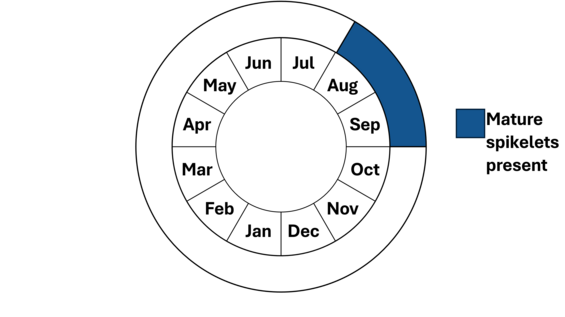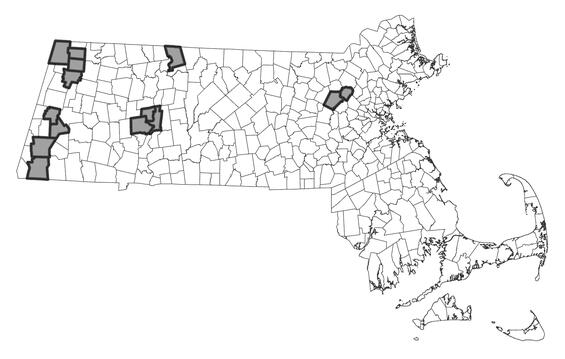- Scientific name: Eragrostis frankii
- Species of Greatest Conservation Need (MA State Wildlife Action Plan)
- Special Concern (MA Endangered Species Act)
Description
Frank’s lovegrass, Eragrostis frankii, is an annual grass with repeatedly branched, erect culms, 1-3 dm (4 – 12 in) high. It has narrow leaf blades that are 5-13 cm (2-5 in) long and 1-3 mm (0.04-0.12 in) wide. Its tiny spikelets are ovate and typically 3-5 flowered. A technical manual should be used for identification.
Nine other species of Eragrostis are recorded from Massachusetts. The following species are from the same habitat as E. frankii: sandbar lovegrass, E. hypnoides, tufted lovegrass E. pectinacea, India lovegrass, E. pilosa, and stink-grass E. cilianensis. Frank’s lovegrass can be told from all of them by the combination of erect plants, long-elliptic inflorescences usually one-half the height of the plant, tiny spikelets with only three to five flowers or fruits, and second glumes as long as the lowest lemma.
Eragrostis frankii single plant in habitat. Photo by Bruce A Sorrie.
Eragrostis frankii inflorescence. Photo by Bruce A Sorrie.
Eragrostis frankii close up of inflorescence. Photo by Brett Trowbridge.
Life cycle and behavior
Frank’s lovegrass is an annual species. This means that the population in an appropriate habitat can vary widely from year to year, and to get an accurate assessment of the size of a population, it should be surveyed several years in a row. The flowering season is August-September. This is a wind-pollinated species.

Population status
Frank’s lovegrass is listed under the Massachusetts Endangered Species Act as a species of special concern. All listed species are protected from killing, collecting, possessing, or sale and from activities that would destroy habitat and thus directly or indirectly cause mortality or disrupt critical behaviors. There are currently 17 occurrences in the state verified since 1999 found in Berkshire Middlesex, Franklin, Hampden, and Hampshire Counties. Three of these populations are assessed to be doing well. Twelve historical occurrences with specific locational information were in Berkshire, Essex, Franklin, Hampden, and Hampshire Counties.

Distribution in Massachusetts. 1999-2024. Based on records in the Natural Heritage Database.
Distribution and abundance
Frank’s lovegrass is known from southern New Hampshire to Minnesota, south to Florida and Oklahoma. In New England, it is possibly extirpated from New Hampshire, considered vulnerable in Massachusetts and Vermont, and not known from Maine or Rhode Island.
Habitat
Frank’s lovegrass prefers sandy riverbanks and sandbars. In Massachusetts, it has been found along the Housatonic and Connecticut Rivers. It also occurs in wetland areas that may experience variation in hydrology over the growing season, sometimes being flooded and sometimes exposed and dry.
Healthy habitats are vital for supporting native wildlife and plants. Explore habitats and learn about conservation and restoration in Massachusetts.
Threats
The primary threat to Frank’s lovegrass is that many of the populations are small and one stochastic event could eradicate the population in that location. Large flood events could impact the population by washing seeds significantly downstream and separating them so that when the seed does germinate, it is separated from others and cannot cross-pollinate. Not all the threats to this species are known.
Conservation
Survey and monitoring
As noted above, to get an accurate assessment of the population at any occurrence, it should be surveyed for several (three to five) years in a row. As an annual species, not all the seeds will germinate in the same conditions. Each plant is a separate genet. The best time to survey is August and September when the florets are mature.
Management
All active management of rare plant populations (including invasive species removal) is subject to review under the Massachusetts Endangered Species Act and should be planned in close consultation with the Massachusetts Natural Heritage & Endangered Species Program. This species prefers partial to full sun so maintaining a site where it occurs in that condition may be one management action needed. Invasive plant species may shade the population as well and need to be removed or controlled.
Research needs
The ecological needs of Frank’s lovegrass are not fully understood. Research is needed on the length of time the seed will remain viable in the soil. Although some seed is clearly moved by flowing water, it is not known how the seed is moved to locations away from stream banks and sand bars.
References
Gleason, Henry A., and Arthur Cronquist. Manual of Vascular Plants of Northeastern United States
and Adjacent Canada, Second Edition. Bronx, NY: The New York Botanical Garden, 1991.
Haines, Arthur. Flora Novae Angliae. New England Wild Flower Society, Yale University Press, New Haven, CT. 2011.
NatureServe. 2025. NatureServe Network Biodiversity Location Data accessed through NatureServe Explorer [web application]. NatureServe, Arlington, Virginia. Available https://explorer.natureserve.org/. Accessed: 3/4/2025.
POWO (2025). "Plants of the World Online. Facilitated by the Royal Botanic Gardens, Kew. Published on the Internet; https://powo.science.kew.org/ Retrieved 06 January 2025."
Contact
| Date published: | May 8, 2025 |
|---|